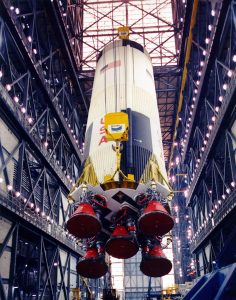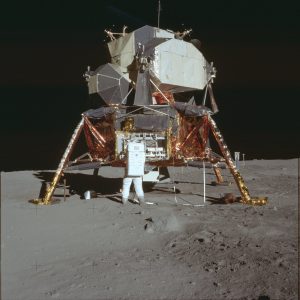By David E. Hubler
Contributor, In Space News
“[I]t’s hard to believe that it has been five decades since Neil Armstrong and I walked on the Moon,” writes astronaut and moonwalker Buzz Aldrin in his foreword to Rod Pyle’s stellar (pun intended) book, “First on the Moon: The Apollo 11 50th Anniversary Experience.” Indeed, it is hard to believe.
Aldrin sums up the thoughts of millions of people around the globe who are now reflecting on what he called “the high point of the twentieth century with regard to human achievement” — the Apollo 11 moon landing on July 20, 1969.

Pyle writes that he and NASA “were born just two years apart (1956 and 1958, respectively).” That proximity engendered in him “a lifelong fascination with space exploration and science” that grew along with NASA’s Gemini program on the mid-1960s. It doesn’t take a NASA rocket scientist to realize how quickly — 11 years to be precise — the nascent space program succeeded in its mission to the moon.
One of the anecdotes Pyle recounts in his photo-filled volume will sound ancient to those not yet born when Neil Armstrong took “one small step for man, one giant leap for mankind.” But the anecdote exemplifies the tremendous interest the NASA program generated by the Apollo 11 flight.
Pyle recalls: “I dragged the two televisions in our house into the living room (no small task in an era when TVs were the size of dishwashers). Both were black and white, befitting the gray and grainy transmissions from the mission. With my dual-screen setup, I was able to view two networks at once — my own private Mission Control.”
The facing page contains what today is called a “screen grab” — a blurry, black-and-white image of a TV screen soon after the landing with the caption, “LIVE FROM THE SURFACE OF THE MOON.” It’s not hard to imagine the glee and pride in the control room after posting those historic words and the sudden awe — and even disbelief — of millions of viewers around the world watching the live transmission from 240,000 miles away.
Another photo in “First on the Moon” is evidence of NASA’s total preparation for whatever might have occurred during Apollo 11’s dangerous mission. It is a copy of a memo dated July 18, 1969, sent by President Nixon’s speechwriter William Safire to White House chief of staff H.R. Haldeman titled IN EVENT OF MOON DISASTER. It begins: “Fate has ordained that the men who went to the moon to explore in peace will stay on the moon to rest in peace.” Well-chosen words, but thankfully not needed.

Return to Earth Was a Precarious Journey
The journey to the moon and the landing on its surface was a precarious exploit; the return to Earth was perhaps even more perilous. The three-man Command Module had to withstand the searing 5,000-degree heat of re-entry into the atmosphere. Then there was the temporary loss of communications with Mission Control in Houston, due to what was described as a plasma cloud around the tiny spacecraft.
Apollo 11 Command Module pilot Mike Collins described the experience as blinding. He noted, “The intensity of illumination has increased dramatically, flooding the cockpit with white light of startling purity… We seem to be in the center of a gigantic electric light bulb, a million watts’ worth at least.” An inspiration, no doubt, for many sci-fi novelists and filmmakers.
Apollo 11 Book the Product of Years of Researching NASA Archives and Private Collections
Pyle succeeded in his mission too. He is a prolific writer for the NASA Jet Propulsion Lab and a frequent speaker at science and technology conferences, such as the annual National Space Society gathering. He spent several years going through NASA archives and private collections for documents, photos and memorabilia to include in his history of the Apollo 11 mission. His work has paid off handsomely.
The result is a 13-chapter, 200-page volume that covers the Apollo mission in splendid photos, artwork and text. “First on the Moon” begins with a photo of President Dwight D. Eisenhower signing the legislation creating NASA and ends with possible plans for the future of our only satellite. These plans include moon mining perhaps, and even a “Moon Village” to be created by the European Space Agency in conjunction with the U.S., Russia and China.

Will Man Eventually Return to the Moon?
One of the more dramatic — and thought-provoking — photos in the book is an artist’s rendering of several large, connected hemispheres and protuberances that would make up the Moon Village. A space-suited astronaut standing outside is dwarfed by the size of the structure, with the curvature of the moon and the Earth visible behind him. A dream now, of course, but in the not-too-distant future, who knows?
Since the last lunar landing of Apollo 17 in December 1972, private entrepreneurs like Elon Musk and Jeff Bezos have picked up the mantle of furthering manned space flight to the moon.
NASA meanwhile has concentrated on exploring our solar system with extraordinarily successful space probes. Voyager 1 and Voyager 2, launched in 1977, have flown past our most distant planets into interstellar space. Both spacecraft – now more than 40 years old –are still sending back scientific information about our solar system.
Pyle foresees a bright future for America’s return to the moon because “the Apollo program taught us much. As a nation, it taught us that we can do what we set our minds to do.”
Our return will begin with the construction of an orbiting space station around the moon in the early 2020s. The Lunar Orbital Platform-Gateway will become a “hub of human activity” in the mid-2020s, allowing astronauts to journey back and forth between the moon and the space station without having to defy Earth’s gravity each trip.

As Pyle writes, “Whether or not this will ultimately succeed has much more to do with politics than capability – America went to the Moon in 1960s technology, and returning there will be much easier with a half-century of technological advancements in hand. It is simply a matter of political will and national priorities.”
The journey of Apollo 11 turns 50 years old this month, but its story never gets old. In Rod Pyle’s learned hands, this detailed, vivid account of man’s first visit to our moon ought to be around for the next 50 years.

Comments are closed.